Sommaire
Independent Haute Horlogerie: Jacob & Co., MB&F, Greubel Forsey, Urwerk, HYT, Angelus, Czapek & Cie
A select circle of watchmaking creators is currently pushing the boundaries of what’s possible. Far from the large traditional Swiss houses, these independents shape timepieces that are more akin to spaceships than simple wristwatches.
Imagine this: tourbillons dancing on three axes simultaneously, colored fluids indicating the time in a capillary tube, or movements faithfully reproducing a Bugatti W16 engine in a functional miniature. These extraordinary complications truly exist.
How did these confidential workshops – Greubel Forsey, MB&F, Urwerk, HYT, and other visionaries – manage to offer mechanical innovations that established giants never dared to conceive? Why are these pieces, often produced in less than 50 examples per year, sometimes traded for over a million euros (approximately 1.125 million USD)?
Between technical feats previously deemed impossible and design fracturing all established codes, these creators transform the classic watch into a true portable kinetic sculpture. Let’s discover this fascinating world where artisanal excellence meets the most radical conceptual audacity.
1. Historical Context: Why These Watches Were Revolutionary
The late 20th and early 21st centuries saw the rise of small independent watchmaking houses, driven by total creative freedom. While large groups dominated the industry, visionary watchmakers chose to follow their own path.
In Geneva in 1997, the founding of Urwerk by Felix Baumgartner and Martin Frei heralded a new era: their watches with satellite display broke aesthetic codes by presenting time in an orbital manner.
Similarly, Maximilian Büsser, after a career at Harry Winston, created MB&F (Maximilian Büsser & Friends) in 2005, a “conceptual watchmaking laboratory” uniting talented artisans to give birth to futuristic “horological machines.”
In this movement, Robert Greubel and Stephen Forsey founded Greubel Forsey in 2004 to push chronometric research to its extremelimits through multi-axis tourbillons.
Jacob & Co., on the other hand, born in New York as a jeweler in the 1980s, burst into haute horlogerie in 2002 with exuberant watches blending jewelry and mechanical prowess.
HYT arrived later (2012) with a revolutionary concept of fluid time reading – literally – thanks to a system of colored fluids in a capillary tube.
As for Angelus, a historic Swiss brand dormant since the 1970s, it was revived in 2015 with models blending heritage and contemporary design.
Finally, Czapek & Cie, the name of Patek Philippe’s co-founder in the 19th century, was reborn in 2015 to reincarnate the spirit of innovation and elegance of yesteryear.
Each of these brands brought a breath of fresh air, even a rupture, in the watchmaking tradition.
This revolutionary character is explained by the desire to break free from usual constraints.
The independents dared unprecedented designs (rocket-shaped cases at MB&F, off-centered or orbital disc displays at Urwerk), never-before-seen complications (fluids indicating hours at HYT, multiple inclined tourbillons at Greubel Forsey) and an artistic approach to time measurement.
These watches were revolutionary because they pushed technical and aesthetic limits, opening new perspectives for enthusiasts.
They testify to sharp craftsmanship combined with unbridled creativity, marking recent watchmaking history with major innovations.
2. Major Movements & Complications
Jacob & Co.: Mechanical and Artistic Extravagance
Entering haute horlogerie late, the house of Jacob & Co. distinguished itself with spectacular movements.
In 2007, Jacob Arabo unveiled the Quenttin caliber, a vertical tourbillon paired with a record 31-day power reserve – unheard of at the time.
A few years later, in 2014, the brand struck a chord with the Astronomia Tourbillon and its vertical movement with four satellites woorden under a sapphire dome.
This JCAM10 caliber features a triple-axis tourbillon and mobile elements (a rotating miniature Earth, a “Jacob-cut” diamond simulating a star) that make a full revolution in 10 or 20 minutes. Jacob & Co. calls this piece “revolutionary” as its 3D architecture rethinks the traditional watch.
The innovation doesn’t stop there: in 2016, the Astronomia Sky caliber added a sidereal display and a rotating celestial map.
Other wild complications followed, such as the Twin Turbo Furious (2018) combining two tri-axial tourbillons and a decimal minute repeater chronograph, or the Bugatti Chiron Tourbillon series in 2020, whose movement integrates an animated mini W16 engine in homage to the supercar (16 miniature pistons move synchronously when a pusher is activated).
Jacob & Co. also patented the split-flap world time system (Epic SF24 watch in 2013) and created the musical watch Opera playing melodies via a cylindrical chime.
Each Jacob & Co. movement is distinguished by a spectacular complication – central triple tourbillon for the Mystery Tourbillon, simultaneous indication of multiple time zones on the original Five Time Zone – always pushing technical limits further to serve a theatrical staging of time.
MB&F: Conceptual Calibers and Kinetic “Machines”
From its beginnings in 2007 with the HM1 (Horological Machine N°1), MB&F has emphasized the movement as a work of art in its own right. The HM1 had four parallel barrels and a display on two dials.
The HM4 Thunderbolt (2010) is a striking example: its entirely in-house designed caliber, developed over three years, comprises 311 components, two horizontal barrels, and two vertical gear trains delivering energy to the two display “pods” (hours/minutes on the right, power reserve on the left).
This movement, housed in an avionic case, earned MB&F the Design Watch Prize at the GPHG 2010.
MB&F explores unprecedented watchmaking architectures: the HM3 (2009) features two domes indicating hours and minutes via rotating cones, and the “Frog” version of this caliber uses sapphire globes reminiscent of frog eyes.
The HM6 Space Pirate (2014) carried a spherical engine with five domes (four tourbillons and a central indicator).
Parallel to the futuristic HMs, MB&F launched the Legacy Machine (LM) series in 2011 with a more classic style but technical prowess: the LM1 features a large suspended balance wheel above the dial and two independent time displays on the same caliber developed with Jean-François Mojon.
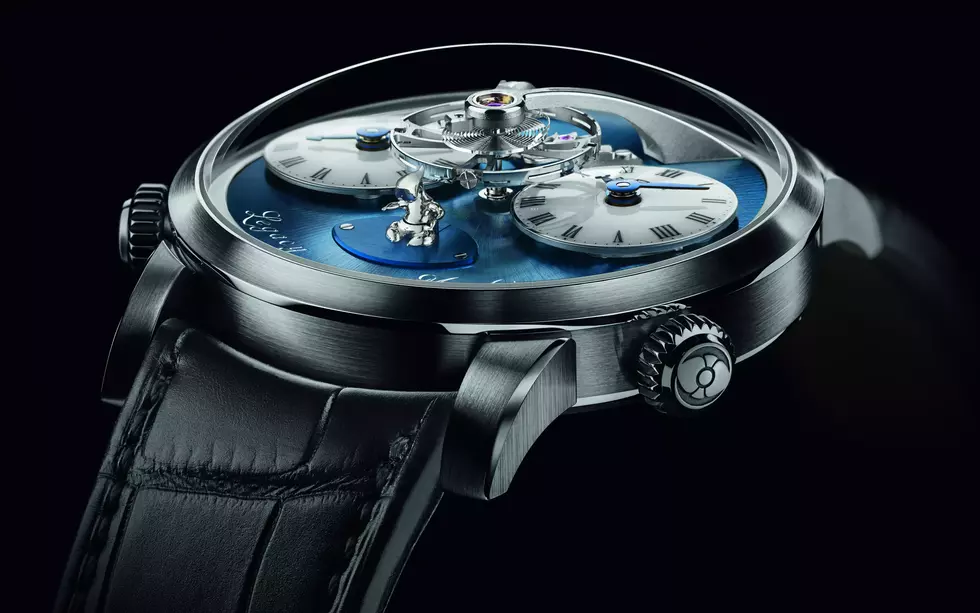
The LM Perpetual (2015), on the other hand, reinvents the perpetual calendar with a “from scratch” movement eliminating the usual frailties of this complication (no blocking date jumps).
Another innovation, the HM7 Aquapod (2017) equipped with a central tourbillon and a jellyfish-inspired rotor.

More recently, MB&F has created collaborative calibers (with Stepan Sarpaneva for the MoonMachine, with L’Épée for mechanical clocks).

Each MB&F movement is designed as a kinetic sculpture: the display, the regulating organ, and the overall architecture merge to give life to extraordinary time machines.
Greubel Forsey: Tourbillon Innovations and Extreme Finishes
Greubel Forsey was built around the tourbillon, seeking to improve precision through multi-axis systems.
Their first movement in 2004, the Double Tourbillon 30°, features an internal tourbillon inclined at 30° making a rotation in 60 seconds, inside an external cage rotating in 4 minutes. This invention, a true “tourbillon within a tourbillon,” was awarded for its chronometric excellence.
In 2009, Greubel Forsey introduced the Quadruple Tourbillon (two double tourbillons coupled by a differential) and the Tourbillon 24 Secondes (a single fast cage at 24s, inclined at 25°) – micromechanical feats intended to optimize isochronism.
Their calibers are also characterized by unparalleled manual finishes (mirror-polished bevels, frosting, impeccable internal moldings) and original indications such as the sectoral power reserve.
In 2011, the brand surprised with the GMT movement displaying a rotating terrestrial globe as an indicator of the world time zone: a sphere makes one revolution in 24 hours, visible on the dial and movement side, coupled with an inclined tourbillon.
The GMT Earth version pushes this concept further by offering a full view of the globe.
Greubel Forsey also innovated with highly legible calendars and experimental watches like the Art Piece 1 (integrating a micro-sculpture visible through a microscope housed in the movement).
More recently, the caliber of the Hand Made 1 (2019) caused a sensation by being 95% handmade, demonstrating extreme know-how.
With each new creation – from the Balancier Contemporain to the GMT Sport – Greubel Forsey brings unique technical solutions (spherical differentials, relief-engraved indications) while maintaining an unmatched level of manual decoration in the industry.

Urwerk: Satellite Displays and Futuristic Mechanics
Since the presentation of the UR-101/102 in 1997, Urwerk has focused on a different way of reading time.
The founding concept is that of satellite hours: several “satellites” carrying the hour numerals orbit along a minute arc.
The caliber of the UR-103 (2003) perfects this system: four discs rotate and successively present the current hour on a semi-circular dial graduated for the minutes. This manual movement also displays autonomy via a gauge on the back.
In 2011, Urwerk went further with the UR-110 caliber, arranging the satellites horizontally and making them scroll obliquely, all driven by turbines regulating the automatic winding.
The spectacular UR-210 (2012) introduced the winding efficiency indicator: its UR-7.10 automatic caliber measures the difference between the energy consumed by the balance and that supplied by the winding (via a unique “Windfänger” hand).
It is also one of the first movements with user feedback.
Urwerk also explored the blend of traditional mechanics and electronics with the EMC (Electro Mechanical Control, 2013): a manual caliber equipped with an optical sensor and an integrated electronic oscilloscope allowing the watch’s rate to be measured and the rate-adjuster to be adjusted accordingly – a true pocket regulator watch for the enthusiast.
In 2018, the AMC (Atomic Mechanical Control) pushed the concept to an unprecedented level: an assembly coupling a reference atomic clock and a mechanical watch that connects to it to be automatically set and rewound.
Finally, more recent calibers like the UR-100 (2019) display not only time in a satellite manner but also astronomical data (Earth’s rotational distance, etc.) on additional scales, showcasing the extent of Urwerk’s creativity.

All Urwerk movements share a common signature: they reinvent the dial, offer the wearer a playful interaction (winding style adjustments, precision control) and sport a resolutely futuristic design, transforming each watch into a temporal “spaceship” on the wrist.
HYT: The Hydro-Mechanical Revolution
HYT (Hydro Mechanical Timepieces) is undoubtedly the most atypical of these brands, combining mechanics and the principle of the clepsydra (water clock).
Its founding movement, that of the HYT H1 launched in 2012, combines a manual mechanical caliber (created in partnership with APRP) with two flexible bellows driven by an eccentric cam.

These bellows alternately push two immiscible fluids inside a thin capillary tube encircling the dial: the interface between the colored and transparent liquids indicates the time in an analog manner (the advance of the colored liquid along the hour scale).
Every day at 6 o’clock, the colored liquid returns to zero by instantaneous retrograde.
The technical challenge – perfect sealing, special fluids with controlled expansion – was a tour de force.
HYT thus invented the hydromechanical indication of time, patenting this unique system.
Subsequent models, such as the HYT H2 (2013, development with Audemars Piguet Renaud & Papi) made the movement more complex: the H2 introduced a V-shaped arrangement of the bellows, a liquid thermometer, and an additional complication (winding position indicator).
The HYT H3 (2015) went even further by abandoning the circular dial: its movement features a straight horizontal tube where the fluid progresses in front of a rotating prism carrying the hours – all driven by a linear rack and a tourbillon on the movement side.
The H0 series (2017) simplified the aesthetics with a panoramic sapphire dome, while the H4 introduced luminescent variants (micro-generator LEDs powered by winding).
After a hiatus in 2020, HYT was relaunched with the Hastroid and Moon Runner line (2022), equipped with new, improved calibers designed by Eric Coudray and design by Davide Cerrato.
The fluidic principle is found here, but with additional complications such as three-dimensional moon phases and the calendar on the dial’s periphery (Moon Runner).
HYT’s innovation thus lies in the bold marriage of traditional mechanics (gears, barrel, and often even a tourbillon on some models) with a high-tech fluidic circuit, offering an unprecedented, almost organic visual time reading.
Angelus: Resurrection and Skeleton Movements
Angelus has a particular history: a manufacture founded in 1891 and renowned for its chronographs and vintage alarm watches (we owe it the Chronodato of 1942, the first wristwatch chronograph with a full calendar), it fell dormant around 1980.

Its rebirth in 2015 under the aegis of La Joux-Perret was marked by the launch of the Angelus A100 caliber in the U10 Tourbillon Lumière.
This impressive piece adopts an “offset” architecture: the movement is housed in a wide rectangular plate, with at one end a 1-minute flying tourbillon fully exposed on the side thanks to a sapphire window, and at the other end a separate hours-minutes dial.
The manual winding caliber offers 90 hours of power reserve and exhibits its gear trains through multiple windows.
Angelus thus shows its ability to combine original construction and high-end finishes (bevelling, Côtes de Genève) in the same movement.
Subsequently, Angelus distinguished itself with contemporary skeletonized calibers: the A-300 movement of the U20 Ultra-Skeleton (2016) integrates a flying tourbillon and prioritizes lightness (carbon plate, openworked titanium bridges).

The U30 chronograph (2017) features an automatic caliber combining a flyback chronograph with double column wheels, tourbillon, and power reserve indicator – a rare synthesis of complications housed in a fully skeletonized structure, revealing the chronograph’s horizontal clutch and the tourbillon’s rotation simultaneously.
Angelus has also revisited historic functions with modernity: the A-500 caliber of the new Chronodate (2023) reinterprets the triple calendar chronograph (date by peripheral hand) in a contemporary, refined, and optimized automatic version.

Between industrial design and heritage tribute, Angelus movements are characterized by a generous use of sapphire (numerous transparent dials and case backs), a search for symmetry and depth in the skeletonization, and the integration of useful complications (power reserve, dual time zone on some editions).
The convergence of these mechanical elements in an avant-garde form demonstrates that the resurrection of Angelus was done in the spirit of innovation that animated the brand in its early days, while exploiting the watchmaking advances of the 21st century.
Czapek & Cie: Reinvented Tradition and In-House Movements
Czapek & Cie, relaunched in 2015, draws inspiration from the heritage of François Czapek (a 19th-century watchmaker) while adopting modern solutions.
Its first movement, the SXH1, was developed with Chronode and integrated into the Quai des Bergues – a two-hand watch with a power reserve indicator inspired by an old Czapek pocket watch model.
This manual winding caliber offers 7 days of power reserve via two barrels and boasts a beautiful traditional architecture (“Parisian square” crown wheel, bridges with côtes ornamentation).
Precision and robustness were present, and this movement earned Czapek the public prize at the GPHG 2016.
In 2018, the brand introduced the SXH3 automatic caliber in its Faubourg de Cracovie chronograph: designed on a Vaucher base, it is a high-frequency integrated chronograph (36,000 vph) equipped with a column wheel, offering excellent reliability and allowing Czapek to offer a sporty chronograph in an elegant case.
However, it is the release of the Antarctique collection in 2020 that marks a technical turning point for Czapek: it is accompanied by the SXH5 in-house caliber, with a micro-rotor.
This automatic movement with a platinum micro-rotor is distinguished by a contemporary openworked aesthetic – bridges shaped like a Maltese half-cross – and by careful technical solutions (ceramic bearings, large inverted central wheel to refine the profile).
The SXH5 displays hours, minutes, seconds, and date, with 60 hours of power reserve, and was designed for reliability and precision (chronometer).
It is one of the movements that has consolidated Czapek’s credibility as a new manufacture.
The SXH7 declination for the Antarctique Rattrapante adds the split-seconds chronograph complication, exploiting a module developed with Jean-François Mojon to result in one of the rare automatic winding split-seconds chronographs available on the independent market.

Through these choices, Czapek blends tasteful classicism – “ricochet” guilloché dials, traditional complications like the calendar or moon phase in the Place Vendôme Tourbillon – with a current design of movements, calling on the best Swiss partners for the ébauches then personalizing them with a touch of originality (finishing, architecture, decorated rotor).
The brand thus demonstrates that it is possible to resurrect a historic name by anchoring it in modern watchmaking, via high-performance and aesthetically accomplished calibers.
3. Essential References
Throughout these innovations, each house has produced flagship models that have become true “great classics” of independent watchmaking. Here is a selection of essential references from each of the brands discussed, with their distinguishing features:
| Brand | Emblematic Model | Key Features | Year |
|---|---|---|---|
| Jacob & Co. | Astronomia Solar “Constellations” | Central tri-axial tourbillon, 3D display with terrestrial globe and diamond star, enveloping sapphire dome | 2014 |
| Jacob & Co. | Bugatti Chiron Tourbillon | Movement inspired by the W16 engine, piston animation, inclined tourbillon, limited edition 72 pcs. | 2020 |
| MB&F | Horological Machine N°4 “Thunderbolt” | Aerodynamic bi-pod caliber, dual display (hours / reserve), airplane fuselage design, titanium and sapphire | 2010 |
| MB&F | Legacy Machine No.1 (LM1) | Dual time zone, large suspended balance wheel above the dial, 19th-century style finishes, inaugural Legacy edition | 2011 |
| Greubel Forsey | Double Tourbillon 30° | Double tourbillon cage (one inclined at 30° within the other), 4 minutes per external rotation, visible architecture on dial and case back | 2004 |
| Greubel Forsey | GMT “Earth” | World time display by a globe rotating in 24h, 24-second tourbillon, simultaneous GMT and local time indicator | 2011 |
| Urwerk | UR-103 | Orbital satellite display, four rotating hour blocks, first iconic Urwerk series, innovative curved case | 2003 |
| Urwerk | UR-210 “Maltese Falcon” | Satellite wandering hours, retrograde minute hand, winding efficiency indicator, DLC titanium case | 2012 |
| HYT | H1 | First fluid watch, bellows and capillary for hour display, hybrid manual caliber, 48mm case | 2012 |
| HYT | Moon Runner Supernova Blue | Fluidic hour, central spherical moon phase, radial full calendar, 72h manual movement by Eric Coudray | 2022 |
| Angelus | U10 Tourbillon Lumière | Lateral flying tourbillon under sapphire glass, separate power reserve indicator and small seconds, unique 90h manual caliber | 2015 |
| Angelus | Chronodate Titanium | Automatic tricompax chronograph, peripheral calendar (“chronodate”) inspired by 1942, 25-piece titanium edition | 2023 |
| Czapek & Cie | Quai des Bergues Guilloché | 7-day manual caliber SXH1, power reserve display and small seconds, traditional guilloché dial, inspired by pocket watch No. 3430 | 2015 |
| Czapek & Cie | Antarctique “Passage de Drake” | Sport-chic steel watch, openworked SXH5 automatic caliber with micro-rotor, integrated bracelet, textured “ricochet” lamé dial | 2020 |
Each of these references embodies the spirit of its brand.
For example, Jacob & Co.’s Astronomia is a true mechanical theater for the wrist, while MB&F’s HM4 symbolizes the fusion of aeronautical design and haute horlogerie.
Greubel Forsey’s Double Tourbillon 30° has become a milestone in chronometric precision, and Urwerk’s UR-103 laid the cornerstone of modern satellite display.
At HYT, the H1 inaugurated a new hydro-mechanical era, just as Czapek’s Antarctique redefined the young brand in the luxury sports watch segment.
These “essential” watches are prized by collectors and often difficult to acquire, as they are produced in limited quantities.
4. Price Evolution (2025)
The market for these exceptional timepieces has seen notable evolutions in recent years. In 2025, one can observe fairly wide price ranges for each of these independent brands, depending on the materials, complications, and rarity of the models:
- Jacob & Co.: Entry-level models (Epic X collection or simple Palatial) start around €20,000 (approximately $22,500 USD), while limited edition complicated pieces soar very high.
For example, an Astronomia trades новый for around €300,000 to €400,000 (approximately $337,500 to $450,000 USD), and some unique set pieces (like the “Billionaire” full diamonds) exceed €1 to €2 million (approximately $1.125 to $2.25 million USD).
The secondary market shows a slight depreciation on common pieces, but hyper-complex pieces hold their value well, driven by their exclusivity.
- MB&F: With production being very limited, prices hold firm.
Entry-level Legacy Machines (LM101) are around €60,000 to €80,000 (approximately $67,500 to $90,000 USD), while more complex Horological Machines (HM3, HM6, HM9…) range between €100,000 and €250,000 (approximately $112,500 and $281,250 USD) depending on the reference.
Special collaborations (e.g., HM4 Final Edition, limited Performance Art series) have seen their auction prices rise.
In 2025, a pre-owned HM4 Thunderbolt can approach €150,000 (approximately $168,750 USD), often above the original price, testifying to collector appreciation.
- Greubel Forsey: Positioned in the very high-end artisanal segment, the brand generally lists new timepieces above €300,000 (approximately $337,500 USD).
A historic Double Tourbillon was around €350,000 (approximately $393,750 USD), a GMT approaches €500,000 (approximately $562,500 USD), and Grandes Sonneries or Hand Made pieces exceed one million euros (approximately $1.125 million USD).
On the 2025 market, these watches retain a high value given their rarity (around 100 pieces/year).
Institutional collectors (museums, major collectors) compete for them in specialized sales, maintaining stable or slightly increasing prices for emblematic examples or limited series.
- Urwerk: Long an “accessible indie,” Urwerk offers its new models in 2025 around €50,000 to €150,000 (approximately $56,250 to $168,750 USD) depending on complications.
The “simplified” UR-100s are priced below €60,000 (approximately $67,500 USD), while a UR-111C (linear display) or UR-220 (latest Oil Change variation) approaches €130,000 (approximately $146,250 USD).
Historic UR-103 and UR-202 pieces have seen their prices climb on the vintage market: an original UR-103 in good condition can reach €70,000 at auction (approximately $78,750 USD) (whereas it was worth approx. €40,000 (approximately $45,000 USD) ten years ago).
Demand for final editions (UR-210 Last Edition) or prototypes is strong, which has driven prices up – a classic dynamic for a brand announcing the discontinuation of certain series.
- HYT: After its revival, HYT prices range between €70,000 and €150,000 (approximately $78,750 USD and $168,750 USD) for new models.
The Hastroids (fluidic hours only) are around €70-80k (approximately $78,750-$90,000 USD), while the more complex Moon Runner is priced near €120k (approximately $135,000 USD).
The first H1/H2 models on the pre-owned market experienced depreciation after the company’s initial bankruptcy in 2020, with some H1s trading around €25,000 (approximately $28,125 USD) at the time.
But since the takeover, confidence is returning: in 2025, these older HYTs tend to recover in value (a well-maintained H1 can sell for €35,000 (approximately $39,375 USD)).
The new pieces, produced in very small numbers, should hold their value better, or even increase if the brand continues its innovative streak.
- Angelus: Positioned slightly below some competitors in price, Angelus offers new watches between €30,000 (approximately $33,750 USD) (Chronodate titanium) and €80,000 (approximately $90,000 USD) (U23 Tourbillon carbon), with some higher exceptions (unique tourbillon pieces).
In 2025, one can find skeletonized U41s or U42s on the secondary market around €25,000-€30,000 (approximately $28,125-$33,750 USD), showing a slight depreciation for these relatively recent models – likely because the brand is still in its (re)recognition phase.
However, limited editions like the Chronodate “Angels’ Share” in collaboration with Revolution, or the U50 Diver Tourbillon, retain a stable value close to retail due to their collector appeal.
- Czapek & Cie: The brand initially offered very competitive prices given the high quality: for example, the Quai des Bergues in steel was worth ~€10,000 in 2016 (approximately $11,250 USD in 2016).
With growing success, prices have aligned with direct competitors (Moser, etc.).
In 2025, an automatic three-hand Antarctique sells for about €22,000 on a steel bracelet (approximately $24,750 USD). Complication versions (Rattrapante, Tourbillon) climb to €50-80k (approximately $56,250-$90,000 USD).
On the market, some highly sought-after Antarctiques (limited series “Passage de Drake” with special dials) trade above list price, driven by the trend for integrated sports watches and low production volumes.
Conversely, more classic gold/gem models may experience a slight depreciation upon resale.
Overall, Czapek’s price evolution reflects the brand’s rising prestige: those who invested early have seen the value of their watches increase, while today prices are stabilizing at a high level corresponding to the house’s recognition.
In summary, the timepieces from these independent brands are generally in the very high-end price range.
Their rarity and collector enthusiasm maintain a good hold on their value, with some iconic pieces even appreciating over time.
However, disparities are noted: the most extravagant creations (Jacob & Co., Greubel Forsey) reach almost inaccessible peaks, while simpler models or those from younger houses (Angelus, early Czapek) can still be relatively affordable in comparison.
Regardless, acquiring one of these watches represents a significant investment, justified by the artisanal and technical prowess they contain.
5. Buying Tips
Acquiring an independent haute horlogerie watch requires some specific precautions and reflexes, given the value and singularity of these pieces. Here is an authentication and best practices checklist to buy with peace of mind:
- Traceability and Certificates: Demand the original papers (certificate of authenticity, warranty card) and the watch box. Independents often provide very detailed certificates.
Verify serial number consistency between the watch and documents.
For pre-owned watches, an extract from the archives or a direct verification with the brand (when possible) can confirm the piece’s history.
- Authenticity of Components: Observe the watch carefully from various angles. At this level of finishing, the slightest inconsistency is suspicious.
For example, an undecorated balance wheel on an MB&F or poor-quality screws on an Urwerk would be a warning sign – these houses apply extreme care to every component.
If in doubt, do not hesitate to have it examined by an expert independent watchmaker specializing in high-end watches.
- Condition and Service: Prefer recent watches in good original condition. Light wear scratches are acceptable, but beware of poorly executed restorations (brushing of titanium or excessive polishing erasing sharp edges).
Ask if the watch has been serviced regularly.
Ideally, an authorized service center or the manufacture itself should perform revisions, especially for complex systems (multiple tourbillons, HYT fluids). Service invoices are a reassuring plus.
- Specific Pitfalls: Know the potential weaknesses of the coveted model. For example, early HYT H1s had fluid micro-leakage issues – ensure the watch has received an update or repair for this defect.
Similarly, Urwerk watches with special coatings (e.g., black DLC on UR-210) should be inspected for potential chips or wear on the surface treatment.
For very complicated watches (repeaters, perpetual calendars), verify the proper functioning of all functions before purchase.
- Deal with Trusted Sellers: Given the niche these brands represent, turn to official distributors or recognized specialists.
Establishments like Exquisite Timepieces are, for example, authorized for several of these brands (Jacob & Co., Czapek, HYT…), which guarantees authenticity and after-sales service.
For pre-owned pieces, prefer reputable auction houses or secure second-hand platforms that offer an authenticity guarantee (some sites offer an in-workshop inspection before finalizing the sale).
- Negotiation and Comparison: The market for these watches can be less liquid than that of established brands. Take advantage of this to compare offers and possibly negotiate.
The exact model, the presence of options (an additional bracelet, a personalized engraving), and the remaining warranty period can play a role.
Inquire about availability: if it is a piece still in production but with a waiting list, evaluate the interest of buying immediately with a small premium over the boutique price, versus waiting several months.
For discontinued watches, monitor past auction results to know the price trend.
- Resale and Future Maintenance: Finally, consider the long-term maintenance aspect from the time of purchase. These houses generally offer reliable after-sales service, but in the event of business cessation (as was the case with HYT in 2020, fortunately temporary), spare parts and required skills could become scarce.
This is a parameter to keep in mind. In case of resale, keep all elements well (documents, accessories) as the next buyer will attach great importance to them and this will enhance the value of your watch.
By following these tips, the purchase of an independent haute horlogerie watch can be made with full confidence, whether it is a new model by subscribing to an exclusive list or a very rare pre-owned piece found from a collector.
Do not forget that passion should guide this purchase as much as reason: take pleasure in exchanging with connoisseurs, discovering the history behind each caliber and, once the watch is on your wrist, appreciating the extraordinary work it represents.
Conclusion
Independent brands such as Jacob & Co., MB&F, Greubel Forsey, Urwerk, HYT, Angelus, or Czapek & Cie have profoundly marked contemporary watchmaking.
In just two decades, these time artisans have pushed the boundaries of technique and design, creating mechanical art objects that fascinate collectors and enthusiasts.
Their atypical historical context – often a reaction to prevailing conservatism – explains the revolutionary character of their watches.
Each has brought its share of innovations: new ways of displaying time, unprecedented complications, innovative materials.
The essential references they have produced are now milestones of 21st-century haute horlogerie, and the sustained interest of the specialized public is reflected in prices that remain at high levels, or even increase for the most sought-after pieces.
The purchase of one of these watches must be carefully considered and accompanied by the usual verifications, but it offers in return the satisfaction of owning a truly extraordinary watch, the fruit of the passion and know-how of visionary watchmakers.
Beyond the simple measurement of time, these timepieces embody a philosophy of independence and uncompromising creativity – wearing one of these watches is a bit like wearing the future of watchmaking on your wrist, while honoring a secular artisanal heritage.
Ultimately, independent haute horlogerie houses offer timepieces at the crossroads of art and technique, whose possession and contemplation provide a unique emotion to enlightened amateurs.

